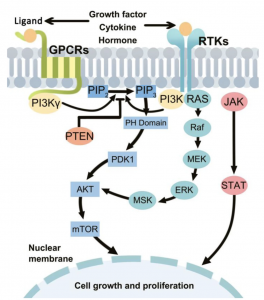Introduction to autism:
The number of children diagnosed with autism in the United States continues to rise. Many studies are being done to understand what is causing autism. Autism is a neurodevelopmental disorder that impacts various parts of the brain: hippocampus, cerebellum, amygdala, and cerebral cortex. Distinguishing characteristics can include atypical neuronal synapse development, neuroinflammation, and oxidative stress to cause many symptoms associated with autism. The atypical development of the aforementioned brain regions and distinguishing characteristics can give rise to trouble communicating, difficulty with memory and cognition, reoccurring behaviors, over-excitation, difficulty to maintain concentration, and sensory/motor deficits.
Pathway of interest:
One pathway of interest to better study autism is the PI3K-AKT/mTOR signaling pathway. In the typical PI3K-AKT/mTOR pathway, as depicted in Figure 1, a ligand will bind to a RTK (receptor tyrosine kinase) to activate PI3K, which is a kinase to activate other molecules downstream. PI3K functions to aid in axonal guidance, making PI3K pivotal in making connections within the brain. PI3K will then aid in the activation of AKT, another kinase. AKT functions in growth and development. AKT then activates mTOR. mTOR is responsible for autophagy, clearance of damaged organelles in the cell, and protein synthesis to allow cells to grow.

Gene mutations and autism:
The abnormal development of the brain that contributes to autism can occur from multiple malfunctions in the PI3K-AKT/mTOR signaling pathway. One potential contributor to dysregulation in the PI3K-AKT/mTOR pathway is a mutation in the gene that encodes PTEN, an inhibitor of PI3K, functioning to aid in cognition and concentration. When there is a mutation, PTEN fails to inhibit PI3K, so the neuronal pathway is overactivated. Another gene mutation can be traced to TSC1/TSC2, which typically works to inhibit mTOR, and is responsible for communication and motor control. Another gene of interest is DDIT4, which is another inhibitor of mTOR. A failure to inhibit downstream mTOR reduces a neuron’s ability to do autophagy, further reducing essential processes needed for neuronal survival.
What causes autism?
Some studies have found that maternal lifestyle and health status during pregnancy significantly impacts the likelihood of having a child with autism.
Diabetes:
Mothers with Type I, Type II, and gestational diabetes diagnosed before 26 weeks increased the likelihood of having a child with autism. Women with diabetes also have hyperglycemia, which can cause oxidative stress in the placental tissue and transfer to the cord blood. The oxidative stress can increase the likelihood of chronic inflammation and epigenetics (changes in gene expression) to the fetus. Also, diabetes in pregnant women generally cause increased inflammation in the uterus to increase fetal brain inflammation. Inflammatory cytokines can bind to TLRs (toll-like receptors), which aid in stimulated the already over-activated PI3K-AKT/mTOR pathway. Furthermore, women with gestational diabetes have atypical placentas that are larger due to autophagy being inhibited, this is also seen in the fetus as the mass of brains later in life are greater.
Nutrition:
Maternal nutrition is essential to support a developing fetus, which is why vitamin and mineral intake is being investigated as a possible factor in the development of autism. Some studies have closely examined vitamin D. Vitamin D upregulates PTEN expression and DDIT4 expression to reduce the overall stimulation of the PI3K-AKT/mTOR pathway that could be responsible for autism. Researchers found that mutations in PTEN can be traced back to maternal vitamin D intake to show that mothers correlate higher vitamin D intakes with lower rates of offspring diagnosed with autism. Other studies found that autistic children benefited from the intake of vitamin D to reduce some symptoms, but the benefits to the child are limited based on what is going wrong in the PI3K-AKT/mTOR pathway. Low intakes of zinc and folate through pregnancy have also been seen to increase the likelihood of having a child with autism.
So what?
Autism rates in the United States are increasing, but many researchers have not found a specific way to prevent or treat autism. Autism further increases the likelihood of developing neurodegenerative diseases, such as Alzheimer’s disease and Parkinson’s disease. More research is needed to understand what causes atypical neurodevelopment and how symptoms can be treated to improve the current and future quality of life for many people.
Sources
- https://www.scientificamerican.com/article/the-real-reasons-autism-rates-are-up-in-the-u-s/
- https://www.sciencedirect.com/science/article/abs/pii/S0197018621001133
- https://molecular-cancer.biomedcentral.com/articles/10.1186/s12943-019-0954-x
- https://www.ncbi.nlm.nih.gov/pmc/articles/PMC6134431/
- https://www.mdpi.com/2075-4655/5/2/13/htm
- https://www.ncbi.nlm.nih.gov/pmc/articles/PMC6659068/
- https://jamanetwork.com/journals/jama/article-abstract/2247143
